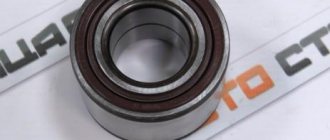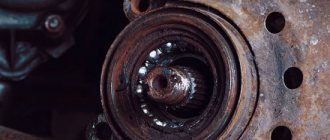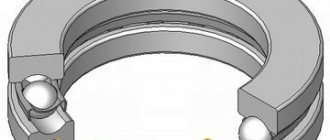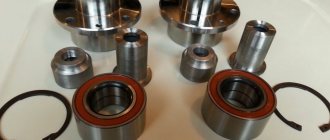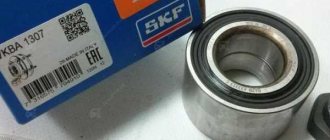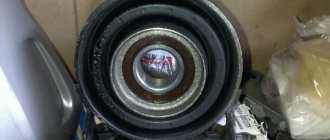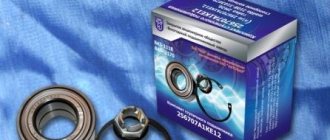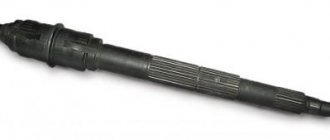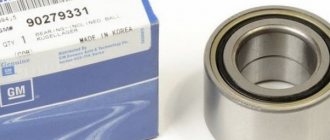The main sign of wear on the VAZ 2106 axle bearing is increased noise from the rear wheel when the car is moving. Replacing the VAZ 2106 axle bearing is required if strong noise in the area of one or another rear wheel occurs both when the vehicle is moving in a straight line and when turning.
It is worth noting that, according to the factory instructions, if such a malfunction occurs, the entire axle shaft assembly must be replaced. Additional pressing or replacement of one bearing with a large axial clearance does not lead to a reliable solution to the problem. The permissible maximum axial play is only 0.7 mm.
The cost of a bearing is from 100 rubles for a Chinese one and up to 250 rubles for an original one. The assembled axle shaft costs several times more. However, it should be taken into account that for craftsmen the cost of performing work on replacing the VAZ 2106 drive shaft assembly is much lower. In this case, you can save money by doing the repairs yourself.
Replacing the rear bearing of Lada 2106 (VAZ 2106)
It is necessary to remove the axle shaft on VAZ 2106 vehicles in exceptional cases, and the main ones can be cited:
Today I will try to show the order of dismantling and installation with a video and photo report. First of all, it’s worth talking about the tool that we need to solve this problem:
- 17 and 19 mm heads
- Ratchet handle and crank
- Extension
- Hammer
- 7 mm deep head with small ratchet
- Penetrating lubricant
So, first I would like to provide a video instruction for this repair, and only then make a detailed photo report of the work done in case the video is suddenly unavailable.
Photo report on the removal and installation of the rear axle shaft on a VAZ 2106
So, the first thing you need to do is remove the rear wheel mounting bolts, jack up the car and finally unscrew the bolts and remove the wheel. After this, it is necessary to remove the brake drum, since it is under it that all the axle shaft mounting nuts are located. As a result, we get the following picture:
Next, you need to align the holes in the axle flange with the fastening nuts. Since there are two such holes, you need to do this twice, of course, then turn the axle shaft so that the third and fourth fastening nuts are accessible in the holes.
It is advisable to first apply a penetrating lubricant and then rip it off with a wrench:
When the force is already small, you can use a ratchet handle for greater convenience:
When all 4 are completely unscrewed, you can then begin to remove the axle shaft. To do this, take the wheel, turn it over and screw it onto two bolts, just tighten it so that there is a slight spread across the bolts. This is clearly shown in the photo below:
And with sharp jerks using both hands we try to pull the axle shaft off the splines. This usually happens after the first jerk, since it does not require much effort:
Next, you can unscrew these bolts and remove the wheel, and finally remove the axle by hand:
After this, you can replace either the axle shaft itself or its bearing if necessary (I’ll write about this in future articles). Installation takes place in reverse order and does not take much time. The only thing worth noting is that when installing it is necessary to ensure that it matches the slots and hit it with a small blow. But I think that everything is clear from the video clip. As for the price of a new axle shaft for a VAZ 2106, it can range from 100 to 1300 rubles.
The main sign of wear on the VAZ 2106 axle bearing is increased noise from the rear wheel when the car is moving. Replacing the VAZ 2106 axle bearing is required if strong noise in the area of one or another rear wheel occurs both when the vehicle is moving in a straight line and when turning.
The cost of a bearing is from 100 rubles for a Chinese one and up to 250 rubles for an original one. The assembled axle shaft costs several times more. However, it should be taken into account that for craftsmen the cost of performing work on replacing the VAZ 2106 drive shaft assembly is much lower. In this case, you can save money by doing the repairs yourself.
Important points
You need to be very careful when cutting off the old bearing with a grinder so as not to touch the axle shaft itself.
It is best to cut off only the outer ring of the bearing and the cage with a grinder. Only a few small cuts (not through) should be made on the inner ring. Then a chisel can be inserted into these cuts and with several careful and precise blows, split the inner ring of the bearing without touching the axle shaft
Only a few small cuts (not through) should be made on the inner ring. Then you can insert a chisel into these cuts and, with a few careful and precise blows, split the inner ring of the bearing without touching the axle shaft.
The new bearing cannot be placed on the axle shaft without effort. In fact, it will have to be stuffed onto the axle. But in no case should you use only a hammer for this, since there is a high risk of distortion and damage. The best way is to take a piece of pipe whose diameter is slightly larger than the diameter of the axle shaft, and use it to seat the part in place. Some car enthusiasts heat the bearings and place them hot on the axle shaft. This really makes it easier to fit the new part because all the metals expand when heated. But it is strictly forbidden to install bearings in this way, since when this part is heated and subsequently cooled in air, it may anneal (that is, heat treatment, which consists of heating the steel to temperatures below critical, followed by slow cooling). Annealing will reduce the hardness of the bearing several times and increase its ductility, as a result, its service life will be reduced significantly.
Replacing a bearing is a difficult task, but it can be done. The main thing here is to avoid damage to the axle shaft when cutting off the bearing and distortions when installing a new part
In addition, you should take into account the fragility of the bearing rings and use the hammer with extreme caution. Otherwise, the procedure is quite within the capabilities of even a novice car enthusiast, who, by doing it with his own hands, can save a significant amount
Replacing the axle shaft assembly
- slotted screwdriver;
- beard;
- installation;
- wrench for “8” and “10”;
- head on “17” with extension;
- balloon key.
- First you need to loosen the bolts securing the corresponding wheel.
- Then you need to place bricks under the front wheels to prevent the car from rolling, move the gear shift lever to the neutral position and release the handbrake all the way.
Operations 8 and 9 should be done very carefully so as not to break anything or tear the rubber lip of the oil seal. The new unit is installed in the reverse order, with the flange positioned with the screws down. At the same time, the bolts securing the rear axle beam of the VAZ 2106 to the oil deflector must be turned with the large edge towards the axle shaft.
Checking status
Replacing front and rear hubs ford focus 2
Checking the condition of the front wheel bearing is not that difficult. You just need to jack up the front wheel, where the bearing is supposed to be worn out. If the car is front-wheel drive, you need to set the gearbox to neutral, put chocks under the rear wheels and put the car on the handbrake. Rear-wheel drive cars use both a gearbox (1st gear is installed) and a handbrake.
You need to grab the jacked wheel with your hands at the top and bottom, and check for play with rocking movements. In a bearing in normal condition there should not be any play, not even the slightest.
Additionally, you need to spin the wheel around the axle. The wheel should rotate easily; the presence of any jamming, as well as a slight crunch or noise, will indicate that the front wheel bearing needs to be replaced.
Video: Diagnostics of the VAZ front wheel bearing.
If you have the appropriate equipment, you can make a replacement in a garage, but you must first purchase a new bearing, as well as related spare parts (hub nut, oil seal, retaining rings).
As for the bearings themselves, they differ on different cars. For example, the VAZ-2106 has two tapered roller bearings at the front, but the Chevrolet Aveo has a double-row angular contact ball bearing.
Due to the differences in these elements used, work to replace them is carried out slightly differently. Therefore, let’s look at how to replace the front wheel bearing on the above models.
Front hub VAZ 2106
One of the important elements of the VAZ 2106 chassis is the hub. This part allows the wheel to rotate. To do this, a wheel disk is screwed onto the hub, and the rotation itself is carried out thanks to a pair of wheel bearings. The main functions assigned to the hub are:
- connection of the wheel disk with the steering knuckle;
- ensuring a high-quality stopping of the car, since the brake disc is fixed to the hub.
To know how hub malfunctions manifest themselves, as well as how to make repairs, you need to familiarize yourself with the structure of this element. Despite the fact that the part is designed to perform complex functions, it is structurally quite simple. The main parts of the hub are the housing and bearings. The body of the part is cast, made of durable alloy and processed on turning equipment. The hub fails quite rarely. The main malfunction of the product is the wear and tear of the outer bearing races at the installation sites.
FakeHeader
Comments 27
Cool article, useful. Thanks to the author!
Thanks for the explanations in pictures and sizes! It was VERY helpful when choosing balanced axle shafts! www.drive2.ru/l/487693881…k7ahVQoCxic7XmhHYj_XDSHj4
How did you solve the issue with changing the axle shaft? How can I install 213 without changing the stocking?
The answer is a little lower in the comments, I wrote it a long time ago.
Please tell me, otherwise everyone says differently, is bridge 213 wider than 2121? Is everything the same in terms of mounting the springs and shock absorbers?
A little longer is not scary. A little thicker isn't scary either. Here is the bearing lock washer you need to look at
hi, I stopped worrying about the old bridge because it died and bought a new one 2113
What is the difference between bridge 2121 and 213? Tell me please
What's stopping you from replacing the bearing and seal?
In my case, this prevents me from drilling out the axle shaft at the bearing seat.
Are the number of splines the same?
And when I bought the car, I saw the oil seals were leaking, I took them apart, and some master installed the axle shaft from an old Niva. I had to replace it with new ones, otherwise a finger would fit between the axle shaft and the oil seal.
Such a master is probably capable of putting a new axle shaft into an old stocking :-) Ignorance is an evil that must be fought against!
I observed something similar. The bridge was dismantled with a grinder, the stocking was thrown away, the axle shaft also had to be sawed. All that remains is to remove the piece of the axle shaft from the gearbox.
Such a master is probably capable of putting a new axle shaft into an old stocking :-) Ignorance is an evil that must be fought against!
I don’t know, I don’t know, I put long axle shafts 2123 in the stocking 2121 and I think it’s hard to call it ignorance :)) www.drive2.ru/l/4890004/
Well, in your case it really doesn’t smell like ignorance, but rather competent modifications, thanks for the link. And the person installed it without spacers or other modifications, that’s what I meant by ignorance.
The rear axle is one of the main components of a car's transmission. Not only the driving performance of the car, but also the safety of the driver and passengers depends on the serviceability of its elements. In this article we will talk about the axle shafts of the rear axle of the VAZ 2107, consider the purpose of these parts, design, possible malfunctions and ways to eliminate them on your own.
Rounded fist
An equally important element of the six's chassis is the steering knuckle. Force is transmitted to it from the steering linkage through the lever, resulting in the rotation of the wheels of the front axle. In addition, ball joints (upper and lower) are attached to the assembly through the corresponding eyes. On the reverse side of the steering knuckle there is an axis on which the hub with bearings is placed. The hub element is fixed to the axle with a nut. The left trunnion uses a nut with a right-hand thread, and the right one uses a left-hand thread . This was done in order to prevent the bearings from being tightened while moving and to avoid overheating and jamming.
An additional function of the steering knuckle is to limit the rotation of the wheels, while the part rests against the levers with special protrusions.
Malfunctions
The resource of the steering knuckle is practically unlimited, if you do not take into account the quality of roads and neglect of adjusting the wheel bearings. Sometimes a product can travel 200 thousand km. The part is made of cast iron and can withstand heavy loads. However, if it fails, the owners of Zhiguli cars often replace it along with the bearings and hub. It is necessary to pay attention to the steering knuckle when the following symptoms appear:
- the car began to pull to the sides, and the problem is not eliminated by adjusting the wheel alignment;
- It was noticed that the wheels turned out at a smaller angle. The cause may be problems with both the steering knuckle and the ball joint;
- wheel break. This happens due to the breaking of the threaded part of the steering knuckle or the ball joint pin, which happens relatively often on Zhiguli cars;
- unadjustable play. If the wheel bearings were adjusted untimely or incorrectly, then in the places where they are installed, the steering knuckle axis will gradually wear out, which will lead to the appearance of play, which cannot be eliminated by adjustment.
Diagnostics
It should be noted that identifying the problem is quite easy. First of all, when driving, an increased howl begins, emanating from the rear axle. If you do not pay attention to this point, then after a while grinding and cracking may begin. As the speed increases, the sound increases significantly.
A fairly strong backlash appears. You can identify it by jacking up and shaking the wheel. It is recommended to check both wheels. After all, it is very problematic to determine by ear whether 1 wheel is howling or 2. In some cases, balls may fall out of the bearing. The most serious problem may be a wheel jam. This happens when the bearing is completely destroyed. If this happens while driving, an accident may occur. Monitor the condition of the bearings in the axle shafts carefully.
Front wheel bearing "six"
The main purpose of wheel bearings is to ensure uniform rotation of the wheels. Each hub uses two single-row roller bearings.
Table: parameters of VAZ 2106 wheel bearings
| Wheel bearing | Options | ||
| internal diameter, mm | outer diameter, mm | width, mm | |
| outer | 19.06 | 45.25 | 15.49 |
| interior | 26 | 57.15 | 17.46 |
The hub bearings last about 40–50 thousand km. When installing new parts, they are lubricated for their entire service life.
Malfunctions
A broken wheel bearing can cause an accident. Therefore, their condition must be periodically monitored and any extraneous sounds or unusual behavior of the machine must be responded to in a timely manner. If play is detected, the elements need adjustment or replacement. The main symptoms indicating problems with the wheel bearings are:
- Crunch. Due to the destruction of the separator, the rollers inside the device roll unevenly, which leads to the appearance of a metallic crunch. The part must be replaced.
- Vibration. If the bearing wears too much, vibrations are transmitted to both the body and the steering wheel. Excessive wear and tear may cause the product to jam.
- Pulling the car to the side. The malfunction is somewhat similar to incorrect wheel alignment adjustment, which is caused by the bearing getting wedged.
How to check a bearing
If you suspect that the wheel bearing on one side of your car is faulty, you should follow these steps to check its functionality:
- Raise the front wheel.
- We place a stop, for example, a stump, under the lower arm, and then lower the jack.
- We grab the wheel with both hands at the top and bottom and try to tilt it towards and away from us. If the part is working properly, then there should be no knocking or play.
Video: checking the wheel bearing on the “six”
How to adjust
If increased clearances are found in the bearings, they need to be adjusted. Tools you will need:
- jack;
- chisel;
- torque wrench;
- head at 27;
- hammer.
The sequence of adjustment actions is as follows:
- Raise the front of the car and remove the wheel.
- Using a hammer and chisel, knock the decorative cap off the hub.
It is recommended to replace the hub nut with a new one when adjusting the bearing, since the fasteners may end up in the same place and it will be impossible to lock it from turning.
Bearing replacement
During the operation of the bearings, the cage, rollers and the races themselves wear out, so the part must only be replaced. To do this, you will need the same list of tools as when adjusting the clearance in the bearings, plus you also need to prepare:
- key for 12 and 27;
- beard;
- head at 17;
- knob;
- flat screwdriver;
- Litol-24 lubricant.
We carry out the work as follows:
- Raise the front of the car and remove the wheel.
- We remove the brake pads and caliper. We fix the latter in the wheel well to prevent tension on the brake hoses.
Video: replacing the wheel bearing
Which to choose
Owners of classic Zhiguli cars, sooner or later, have to deal with replacing wheel bearings and the issue of choosing a manufacturer. Today there are many companies that produce products of this type. But it is better to give preference to the following brands:
The products of these manufacturers are characterized by high quality and meet the most stringent requirements.
If we consider domestic manufacturers of bearings, then they also exist. Bearings are supplied to AvtoVAZ by:
- CJSC "LADA Image" is a supplier of original Lada wheel bearings on the secondary market;
- SPZ (Saratov Bearing Plant);
- Volzhsky Standard (Volzhsky Plant);
- VBF (Vologda Bearing Plant);
- SPZ-9 (Samara plant).
Is it worth buying the original?
It is often advised to buy original bearings. An original is a part selected by a car manufacturer for sale on markets. These are the parts that are delivered to conveyors. When buying an original bearing, you will be absolutely sure that it will suit you. But there are several questions that need to be addressed here.
The original or a fake?
The original bearings are all the same and if you examine it carefully you will find the engraving. It is located on the edge of the upper or lower part. It should contain several information:
- manufacturer (logo);
- Country of Origin;
- designation digital or alphanumeric details, sizes;
- Additional information is possible;
- The kit must include a hub nut (usually disposable), there may be pins or bolts, seals.
- SKF brand
- Full bearing designation
- Manufacturer country
- Production date code
- Deviation of the average outer diameter ∆Dm and the position of the maximum eccentricity of the outer ring
- Deviation of the average bore diameter ∆dm and the position of the maximum eccentricity of the inner ring
- Marking of thrust end, stamping
- Serial number (for bearing sets only)
- "V" marking (matched bearing sets only)
If the country of origin is not indicated, it is not an original, but a fake.
Caliper
When considering the chassis of the VAZ “six”, you cannot ignore the brake caliper. This unit is mounted on the steering knuckle and holds the brake pads and brake wheel cylinders through appropriate holes, slots and grooves. There is a special hole in the caliper for the brake disc. Structurally, the product is made in the form of a monolithic steel part. When the piston of the working brake cylinder acts on the brake pad, the force is transmitted to the brake disc, which leads to the deceleration and stopping of the car. If the caliper is deformed, which is possible with a strong impact, the brake pads wear unevenly, which significantly reduces their service life.
The caliper may receive the following damage:
- appearance of cracks. Since the part is constantly exposed to loads, over time cracks appear on it due to metal fatigue. This indicates the need to replace the caliper, since it is unsuitable for restoration;
- formation of oxides on moving elements. The working cylinders gradually become covered with dirt and an oxide film, and the pistons begin to jam over time, which reduces braking efficiency. In this case, repair or replacement of the cylinders is required.
Wheel bearing: 4 simple ways to check before it’s too late - Advice from experts
Many people know that there are certain bearings in the wheel area called wheel bearings, and from time to time they wear out. But this is where the ideas about the subject end. No problem! Today we’ll talk in detail about what it is and, most importantly, how to determine the need for replacement. And first, a little theory.
Without abstruse definitions, a wheel bearing is a bearing on which the wheel rotates. Of course, we all removed the wheels (or at least were present at this sacrament) and saw that there were no bearings on the wheel itself, and they were also not visible on the one from which they were removed. Right. Because this bearing stands between the fixed axis of rotation and what the wheel is screwed to . The part that acts as a fixed axis is called a fist
A small clarification: the concept of “axis” in this case is used precisely as the geometric axis of rotation, and not as the shape of the part. For example, in the steering knuckles of a front-wheel drive car, this axis is hollow, and the drive shaft passes inside it. See pictures below.
In turn, the part to which the wheel rim is directly attached is called the hub.
. Thus, if you strain your head a little and imagine everything written above, then the following picture emerges: a bearing is put on the fixed axle (or inserted into it, if there is a drive), and a hub is put on the bearing, to which the wheel is screwed. This is such a simple nesting doll. Now about malfunctions and self-diagnosis.
Since today’s hero is not highly complex, the symptoms of the malfunction will be quite clear.
Symptom No. 1
Noises . Those who have ever heard the noise/hum of dry or worn bearings will understand what we are talking about. Those who don’t know shouldn’t despair either. If you have doubts about the serviceability of any hub, simply hang up two wheels of the same axle, put the box in neutral and spin both. I’m sure you can spot a noisy hub right away. The main thing is not to confuse the noise of the bearing with the friction of the pads on the brake disc, so as not to change all four in a fright.
Symptom No. 2
Once you have hung the axle with the suspected wheel, shake it in all directions. A heavily worn bearing will give a play that can be clearly detected by hand . Again, do not confuse the bearing play with the play of the steering tips (if they are also tired). If you lack experience, it is better to call a friend: one will rock the wheel in all directions, the other will look at it from the inside. I’m sure the two of you can easily determine whether the wheel is loose relative to the axle (then it’s a hub wheel), or whether the entire axle assembly is loose relative to the steering rod - then you need to change the tips.
Symptom No. 3
Noticeable heating. Very often the wheel bearing begins to jam and, as a result, heats up. After the trip, touch the wheel (not the brake!) disc with your hand and compare the temperature on the wheel in doubt with the second wheel of this axle. If the hub jams, the temperature will be noticeably higher. And you definitely won’t need thermometers to determine the difference. But again, we take a situation where we are confident in the serviceability of the brake mechanisms: a soured brake caliper can also cause overheating.
Symptom No. 4
And finally, sideways movement when moving . If the hub is already moving into a better world and jams heavily when rotating, this will affect the straightness of movement. The car will drag towards the wheel with a faulty bearing. By the way, as in option “3”, this is always associated with parallel heating of the part and can also be caused by jamming of the caliper, or the handbrake mechanism, if we are talking about the rear wheels. Therefore, the last two points are relevant only with a known-good brake system.
If you find an error, please select a piece of text and press Ctrl+Enter .
Rear wheel axle shaft of VAZ 2106
On the VAZ 2106, the rear wheels are secured using axle shafts. The part is fixed on the rear axle housing and is an integral part of it, since it is the axle shaft that transmits rotation from the gearbox to the rear wheels.
The axle shaft is a reliable part that practically does not fail. The main element that sometimes requires replacement is the bearing.
With its help, uniform rotation of the node in question is ensured during movement. Bearing failures are similar to hub elements. When a part fails, the problem is solved by replacement.
Bearing replacement
To remove the axle shaft and replace the ball bearing, you need to prepare a certain set of tools:
- knob;
- head at 17;
- hammer;
- flat screwdriver;
- chisel;
- Bulgarian;
- new axle bearing with retaining ring;
- blowtorch or gas torch.
Removing the axle shaft
We carry out dismantling in the following order:
- We lift the rear of the car from the desired side and remove the wheel, as well as the brake drum.
- To prevent grease from leaking out of the rear axle beam, lift the edge of the stocking with a jack.
- Using a 17 mm socket wrench, unscrew the axle shaft mount.
The brake pads do not interfere with the removal of the axle shaft, so there is no need to touch them.
Bearing removal
The bearing removal process consists of the following steps:
- We fix the axle shaft in a vice.
- We cut the ring with a grinder.
Bearing installation
We install the new part as follows:
- Remove the boot from the new bearing.
Video: replacing the axle bearing on a “classic”
Although hubs with bearings and axle shafts of the VAZ 2106 are reliable elements, they can still fail due to constant exposure to high loads. The problem is mainly related to the wear of bearings, which the owner of a Zhiguli can replace on his own. To work, you will need a little experience in car repair and a minimum set of tools, and in order to do everything correctly and avoid mistakes, you should first read the step-by-step instructions.
Source
Causes of failure
Every part on a car tends to become unusable. Rear wheel bearings are no exception, but any part has characteristic operational features. If the operating conditions are met, the part can serve for years, which is confirmed by the driving experience of current older drivers.
The main reasons for bearing failure are:
- careless driving;
- incorrect installation of the product;
- water and dust getting inside the hub;
- leakage of lubricant;
- long service life.
If a VAZ-2107 car is often operated in aggressive conditions close to off-road, then the need to replace the rear wheel bearing will not take long to arrive.
It is especially important to take into account the fact that the famous “seven” is a rear-wheel drive car. But how can you determine that a wheel bearing has failed and needs to be replaced? Let's find out in more detail
Methods for determining whether a wheel bearing is faulty
Timely identification of a malfunction allows you to prevent unpleasant consequences that can provoke an emergency situation on the road. The part in question on the VAZ-2107 car plays an important role, since thanks to this product the wheel rotates easily. The car has 2 rear wheel bearings, one for each rear wheel.
The main way to determine the malfunction of an important part of the hub on a VAZ-2107 is to carry out the following manipulations:
- raise the rear of the car on a jack;
- swing the outer part of the wheel in different directions;
- if a knocking noise occurs and the wheel dangles, then the rear wheel bearing of the VAZ-2107 needs to be replaced.
If the car drives while turning corners and a squeaking noise appears, this also indicates the need for repair work. To replace the wheel bearing, you will need the following tools:
- jack;
- wrenches and screwdrivers;
- chisel and hammer;
- puller;
- Litol brand lubricant.
After making sure that you have a complete list of tools and materials for the work, you can begin replacement.
Replacing a faulty product
You must begin replacing the product by loosening the wheel bolts. This must be done before the rear of the car is jacked up. At the same time, do not forget to install stops under the front wheels.
- A jack is installed, then the rear side of the car where the bearing needs to be replaced is jacked up. Once the car is raised, you can install a safety stump in case the jack comes off.
- The wheel is removed, and then the drum. It should be remembered that you cannot put the car on the handbrake, otherwise you will not be able to remove the drum. To remove the drum, you need to unscrew two pins and insert them into the technological holes. When the pins are tightened, the drum is pulled out, after which it can be dismantled.
- Using a screwdriver, pry off the steel cap or protective cover. The 4 nuts securing the axle shaft are unscrewed.
- We use a special puller, with the help of which the hub is removed from the drive axle axle. If there is no puller, then you can use a regular chain or cable, attaching it to the axle shaft.
- It is necessary to remove the worn bearing from the axle shaft using a puller or grinder. To remove the bearing using a grinder, you need to cut the outer race on both sides.
Further actions are performed in the reverse order of removal
It is important not to forget that when replacing a bearing, the sealing seals must also be replaced.
The bearing must not be misaligned, which can lead to its failure on the first day of operation. If you operate the car correctly and carefully, then you can forget about replacing the bearing for 2-5 years. You can also read about replacing the front wheel hub bearing.
